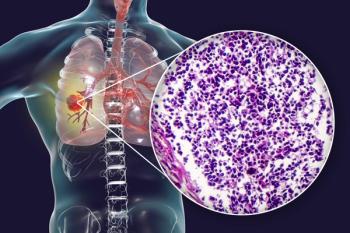
- Oncology NEWS International Vol 16 No 1
- Volume 16
- Issue 1
Annual CT Screening May Overdiagnose Lung Ca in Women
A retrospective review of 61 lung cancers identified during annual CT screening of high-risk individuals found that an exceptionally high rate of tumors may have been "overdiagnosed," particularly in women.
CHICAGOA retrospective review of 61 lung cancers identified during annual CT screening of high-risk individuals found that an exceptionally high rate of tumors may have been "overdiagnosed," particularly in women. Of the 48 cancers that could be assessed for tumor vol-ume doubling times, 27% had doubling times greater than 400 days, defined as "overdiagnosis" by Yankelevitz et al (Cancer 97:1271-1275, 2003), and 85% of these tumors occurred in women, Rebecca Lindell, MD, reported at the Radiological Society of North America 2006 meeting (abstract SSK04-01).
Findings from this study, conducted at the Mayo Clinic, Rochester, add further fuel to the debate over whether lung cancer screening is an effective tool for identifying cancers in high-risk individuals that need to be treated.
As Dr. Lindell pointed out, controversy over the utility of lung cancer screening has a long history, beginning in the 1970s with the Mayo Lung Project and studies at Johns Hopkins University and Memorial Sloan-Kettering (MSKCC). The Mayo Lung Project and its subsequent follow-up study found improved survival without significant reduction in mortality after 20 years. "It was suggested that overdiagnosis may account for the disparity between improved survival rates without change in mortality or that screening chest radiographs were detecting cancers that did not result in death," Dr. Lindell said.
However, a study of stage I lung cancers in the Mayo Lung Project, as well as in patients screened at MSKCC, concluded that chest radiographs did not lead to a high proportion of overdiagnosis of lung carcinomas. The study found that rates of potential overdiagnosis were 2% in the Mayo Lung Project and 7% in MSKCC patients, using the definition of a tumor volume doubling time greater than 400 days, she added.
Mayo Clinic researchers may have found more potential cases of overdiagnosis in the study reported at RSNA than these investigators because they used CT, which is a more sensitive screening tool than chest radiography, or because there was some variation in the way tumor volume doubling times were calculated, Dr. Lindell said. Lesions were measured manually by a single person using electronic calipers available on the computer workstation. The doubling times ranged widely from 10 days to 5,810 days, with an average of 518 ± 1,094 days.
"A more intriguing possibility is that overdiagnosis of cancer occurs primarily in women," she said, pointing out that the two previous studies involved only men. Of the 48 cancers in the current study, 18 were in men and 30 in women. The mean tumor volume doubling time was 688 days in women and 234 days in men. If the current study had only considered men, the potential rate of overdiagnosis would have been 11%, which is more in line with, but still higher than, the previous findings, she said.
Articles in this issue
almost 19 years ago
Nab-Paclitaxel Bests Docetaxel in First-Line Met Breast Caalmost 19 years ago
Congress Plans to Keep NCI Operating at FY2006 Budgetalmost 19 years ago
Lenalidomide Is Active in Relapsed and Refractory NHLalmost 19 years ago
Self-Hypnosis Reduces Anxiety During Breast Biopsyalmost 19 years ago
With Decrease in HRT Use, Breast Ca Incidence Rates Fallalmost 19 years ago
MK-0457 'Glides Past' Bcr-Abl T315i Mutationalmost 19 years ago
Dasatinib Superior to High-Dose Imatinib in Resistant CMLalmost 19 years ago
Lilly 2006 Oncology on Canvas Winners 'Embrace Life'Newsletter
Stay up to date on recent advances in the multidisciplinary approach to cancer.



















































































